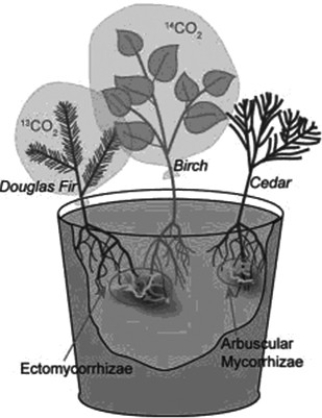Use the following information to answer the question.
Suzanne Simard and colleagues knew that the same mycorrhizal fungal species could colonize multiple types of trees. They wondered if the same fungal individual would colonize different trees, forming an underground network that potentially could transport carbon and nutrients from one tree to another (S. Simard et al. 1997. Net transfer of carbon between mycorrhizal tree species in the field. Nature 388:579-82) .
Pots containing seedlings of three different tree species were set up and grown under natural conditions for three years (Fig.A) . Two of the three species (Douglas fir, birch) could form ectomycorrhizal connections with the same fungal species, but the third species (cedar) could not form an ectomycorrhizal connection with the fungal species. In some of the pots, the researchers placed airtight bags over the Douglas fir and birch seedlings and injected carbon dioxide made from carbon-13 into the bags with the Douglas fir and carbon dioxide made from carbon-14 into the bags with the birch. (¹³C and ¹⁴C are different isotopes of carbon that can be detected and measured by researchers.) As the seedlings photosynthesized, the carbon dioxide was converted into sugars that could be tracked and measured by the researchers. The researchers measured whether the sugars in each plant contained only the carbon isotope that was in the air of their plastic bag or also the carbon isotope from the air around the other plant.
Figure A
Based on the idea that fungi have pores between their cell walls that allow cytoplasm to move from one end of the mycelium to the other, which of the following hypotheses is the most plausible?
Definitions:
Milgram Experiment
A psychological experiment conducted by Stanley Milgram in the 1960s to study obedience to authority, where participants were instructed to administer electric shocks to another person.
Stanford University Prison Experiment
A psychological study conducted by Philip Zimbardo in 1971 at Stanford University, where students were assigned roles of prisoners and guards to explore the effects of perceived power.
Generalization
Drawing a conclusion about a certain characteristic of a population based on a sample from it.
Logical Support
The provision of reasons or evidence to justify a claim or argument.
Q22: Among protostomes, which morphological trait has shown
Q27: Robbie and Saurab are pre-med and pre-pharmacy
Q36: Dinoflagellates _.<br>A) possess two flagella<br>B) are all
Q39: Which of the following groups is matched
Q45: The fact that both charophytes and green
Q54: Use the following information to answer the
Q55: Use the information to answer the following
Q58: The legless condition that is observed in
Q59: You find a multi-legged animal in your
Q65: The presence of vascular tissue allowed plants